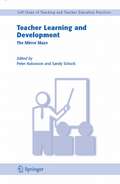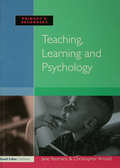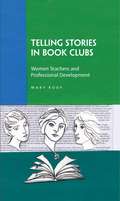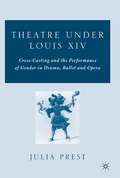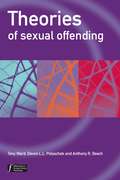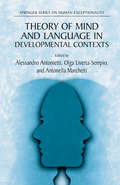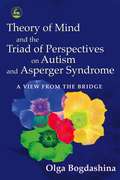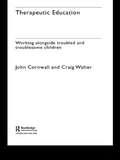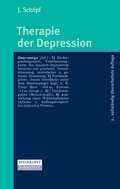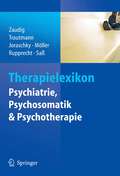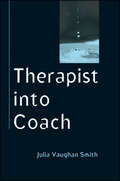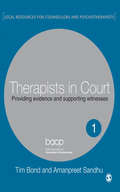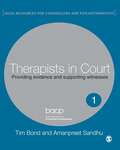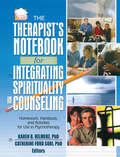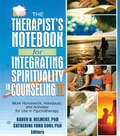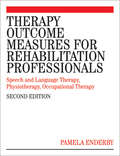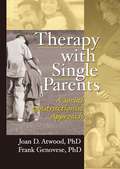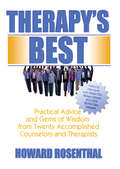- Table View
- List View
Teacher Learning and Development: The Mirror Maze (Self-Study of Teaching and Teacher Education Practices #3)
by Peter AubussonThis series in teacher education, Self-study of Teacher Education Practices (S-STEP), is designed to capture and portray a range of approaches to se- study of teaching and teacher education practices. In so doing, it is anti- pated that the work of teachers and teacher educators might come to be better understood and valued as the complexity of the work of teaching and teaching about teaching is articulated and described for others. The series was initiated in order to complement the International Handbook of Self-study of Teaching and Teacher Education Practices (Loughran et al., 2004) so that the diversity in approaches to self-study could be highlighted for all those involved in the teaching and researching of professional practice. Pinnegar (1998) described self-study as a methodology for studying the s- tings in which professional practice takes place and, as such, suggested that self-study should lead to improvements in teaching and teacher education by uncovering and articulating insights in the processes of teaching and learning. In this way, a clear intention of self-study is that it might ultimately enhance s- dents’learning and teacher and teacher educators’understanding of practice.
Teaching, Learning and Psychology
by Jane Yeomans Christopher ArnoldPresenting a range of psychological theories in a non-technical and readable style, this book shows how psychology can be used to effectively deliver educational objectives and enhance children’s learning. Linking theory with practical application, the authors consider the wider role that schools can play in the social development of children through: teaching and managing individual pupils teaching and managing groups of pupils the teacher as part of an organisation and school system the teacher as part of the community of the school and area. Structured to reflect the standards for QTS and relevant for key stages 1-4, this book shows how understanding the psychological theories underpinning pedagogy can help both trainee and practising teachers become reflective and informed practitioners when faced with new and challenging teaching situations.
Teaching, Learning and Psychology
by Jane Yeomans Christopher ArnoldPresenting a range of psychological theories in a non-technical and readable style, this book shows how psychology can be used to effectively deliver educational objectives and enhance children’s learning. Linking theory with practical application, the authors consider the wider role that schools can play in the social development of children through: teaching and managing individual pupils teaching and managing groups of pupils the teacher as part of an organisation and school system the teacher as part of the community of the school and area. Structured to reflect the standards for QTS and relevant for key stages 1-4, this book shows how understanding the psychological theories underpinning pedagogy can help both trainee and practising teachers become reflective and informed practitioners when faced with new and challenging teaching situations.
Telling Stories in Book Clubs: Women Teachers and Professional Development
by Mary KooyThis book examines questions in the intersections of narrative, teaching, communities of learning, knowledge, women teachers and teacher development. Stories constitute the heart of this book and the glue that holds the pieces together. This book explores the ways women educators understand and make sense of their lives and develop their personal practical knowledge of teaching through narrative texts and experiences in informal learning groups.
Theatre Under Louis XIV: Cross-Casting and the Performance of Gender in Drama, Ballet and Opera
by J. PrestThis book explores the fascinating phenomenon of cross-casting and related gender issues in different theatrical genres and different performance contexts during the heyday of French theatre. Although professional acting troupes under Louis XIV were mixed, cross-casting remained an important feature of French court ballet (in which the King himself performed a number of women's roles) and an occasional feature of spoken comedy and tragic opera. Cross-casting also persisted out of necessity in the school drama of the period. This book fills an important gap in the history of French theatre and provides new insight into wider theoretical questions of gender and theatricality. The inclusion of chapters on ballet and opera (as well as spoken drama) opens up the richness of French theatre under Louis XIV in a way that has not been achieved before.
Theories of Sexual Offending (Wiley Series in Forensic Clinical Psychology)
by Tony Ward Devon Polaschek Anthony R. BeechThis comprehensive text provides an up-to-date review and critique of current theorising about sexual offending. It presents the key ideas underpinning each theory in a clear and accessible manner. Theories are rigorously tested and evaluated, and their merits are examined from both a research and a clinical point of view. Importantly, the emphasis is on providing clear links between theory and practice, and the clinical implications of the different theories and perspectives are explicitly discussed. In addition, a number of new ideas about the aetiology of sexual offending are presented. Theories of Sexual Offending is one of the few books to draw all of the disparate strands of theorising together, and is the only one to clearly link theory to practice. It will be a valuable resource for any professional working with sexual offenders, such as clinical and forensic psychologists, psychiatrists, probation officers and social workers. It will also be of interest to students of forensic and clinical psychology.
Theory of Mind and Language in Developmental Contexts (The Springer Series on Human Exceptionality)
by Alessandro Antonietti Antonella Marchetti Olga Liverta SempioProvides new empirical study data that explores the influence of linguistic variables within developmental contexts on theory of mind development and functioning Establishes context for usage, including personal, social, and business interactions Offers a comprehensive overview on the most current studies that address the relationship between language and theory of mind
Theory of Mind and the Triad of Perspectives on Autism and Asperger Syndrome: A View from the Bridge
by Olga BogdashinaInspired by the often uncomfortable interplay between autistic individuals, parents and professionals in understanding autistic spectrum conditions, Olga Bogdashina uses the concept of Theory of Mind (ToM) to consider these groups' different (and often conflicting) perspectives. ToM is the ability to imagine and make judgements about what others feel and think; its absence in autistic individuals is called 'mindblindness'. This book addresses the 'mindblindness' of people united in their interest in autism but divided by their different angles and perspectives. Divided into four parts, the book first defines autism, then the views of the three main groups working with it - autistic individuals, parents and professionals - under the headings of classifications, diagnosis, causes, development, theories and treatment. By comparing and reconciling the different perspectives in this way, the book helps each group to understand and predict each other's responses and behaviours. This enlightening and innovative book offers a unique way of 'stepping in each other's shoes' and is a valuable resource for all people living or working with autism.
Therapeutic Education: Working alongside troubled and troublesome children
by John Cornwall Craig WalterThe role of therapy in schools is a topic that has been significantly under-researched and often overlooked. Considering the number of students in full-time education with serious emotional and behavioural difficulties, the skills and tricks used by therapists can be usefully passed on to teachers in the classroom. This book traces a substantial four-year project that applied the principles of therapeutic education in one school setting and exposed how current educational contexts actually contribute to disaffection and disruption of young people's learning. The authors propose a practical model of school and curricular experience, based on therapeutic relationships, that has led to outstanding positive results in school development. With suugestions throughout for tried-and-tested strategies that really work, this book will help professionals turn troubled young people's experience of education from the nightmare it often is, into an adventure with positive results for lifelong learning.
Therapeutic Education: Working alongside troubled and troublesome children
by John Cornwall Craig WalterThe role of therapy in schools is a topic that has been significantly under-researched and often overlooked. Considering the number of students in full-time education with serious emotional and behavioural difficulties, the skills and tricks used by therapists can be usefully passed on to teachers in the classroom. This book traces a substantial four-year project that applied the principles of therapeutic education in one school setting and exposed how current educational contexts actually contribute to disaffection and disruption of young people's learning. The authors propose a practical model of school and curricular experience, based on therapeutic relationships, that has led to outstanding positive results in school development. With suugestions throughout for tried-and-tested strategies that really work, this book will help professionals turn troubled young people's experience of education from the nightmare it often is, into an adventure with positive results for lifelong learning.
Therapeutisches Arbeiten mit Träumen: Theorie und Praxis der Traumarbeit
by Klaus-Uwe AdamDas Lehr- und Arbeitsbuch lädt dazu ein, das „Reich der Träume“ für die Therapie nutzbar zu machen. In mehreren Schritten werden Leser an die „Traumarbeit“ herangeführt: Von den theoretischen Grundlagen über die Funktion des Traumes und der Traumsymbole bis zur Methodik und Praxis. Weit über die Beschreibung von Traumsymbolen hinausgehend, vermittelt das Buch systematisch die therapeutische Bedeutung von Träumen. Die verständlich geschriebene Einführung richtet sich an ärztliche und psychologische Psychotherapeuten ebenso wie an interessierte Laien.
Therapie der Depression
by J. SchöpfFür die Behandlung der Depression stehen heute mehrere psychotherapeutische und zahlreiche biologische Therapien zur Verfügung. Wie wirken diese Therapien? Wie werden sie praktisch durchgeführt? Wie wird im Einzelfall aus der Vielzahl der Verfahren die optimale Therapie ausgewählt? Wie geht man mit Therapieresistenz oder Nebenwirkungen um? Diese kompakte Entscheidungshilfe für die Fragen der täglichen Praxis gibt einen Überblick über die aktuellen Behandlungsmöglichkeiten.
Therapielexikon Psychiatrie, Psychosomatik, Psychotherapie
by Michael Zaudig Hans-Jürgen Möller Henning Saß Rolf Dieter Trautmann-Sponsel Peter Joraschky Rainer RupprechtDas Therapielexikon bietet die Vorteile eines Nachschlagewerkes und eines Lehrbuches in einem Werk. Rund 650 alphabetisch sortierte Einträge von A wie "Abhängigkeitssyndrom" bis Z wie "Zyklothymia". Alle Einträge des Therapielexikons sind klar strukturiert. Aktueller Stand des Wissens in Diagnostik und Therapie. Für jedes Störungsbild werden entsprechende EBM-basierte pharmakologische, ver-haltenstherapeutische, psychodynamische oder psychoanalytische Therapieempfeh-lungen beschrieben. Beinhaltet für jede Störung eine ausführliche Beschreibung nach ICD-10 und DSM-IV-TR. Ideal zur Vorbereitung auf die Facharztprüfung Psychiatrie/Psychosomatische Medizin. Ein fundiertes, praxisorientiertes und topaktuelles Nachschlagewerk für Psychiater, Psychosomatiker, Psychotherapeuten und Psychologen, aber auch für Allgemeinmediziner.
Therapist into Coach (UK Higher Education OUP Humanities & Social Sciences Counselling and Psychotherapy)
by Julia Vaughan SmithHow does coaching differ from my current work as a therapist?If I became a coach, what additional skills and expertise might I need?What sorts of markets might I work in and what sort of income could I expect?What are the implications if I decided to run a mixed practice of coaching and therapy/counselling?This book is written for qualified and experienced psychological therapists who are interested in what coaching may have to offer their clients or their practice. It considers what coaching is, the routes by which people have become coaches, the coaching client, coaching methods and the issues within running a mixed practice. This includes a thorough exploration of the points of difference between therapeutic and coaching models, including the nature of interventions, mind set of the coach and the structuring of the process. Aspects of therapeutic models which are inappropriate for coaching are highlighted as well as the elements which add a richness to it. There are examples of dialogue between coach and client and short case studies throughout the book which illustrate the coaching process and exemplify the ‘voice of coaching’.Therapist into Coach provides key reading for psychotherapists, counsellors and psychologists who are thinking of widening the case mix of their practice, of moving into new markets or who want a different relationship with their clients. It will also help coaching trainers or coaching students understand the similarities and differences between coaching and counselling.
Therapists in Court: Providing Evidence and Supporting Witnesses
by Amanpreet Sandhu Tim Bond`A recent SAGE Publication called Therapists in Court provides invaluable, step-by-step guidance to mental health practitioners in the UK. Even though different countries use different legal systems, many issues faced in the legal domain are based on the principle of protecting the rights of both parties and balancing often competing roles. Despite its base in the UK legal system, Therpists in Court provides essential advice on many of these issues for all mental health practitioners, regardless of their location' - New Therapist `[Therapists in Court] spells out very clearly the vastly different worlds of therapy and the courts. Detailed and careful preparation is advised although not offered by the courts to the uninitiated. There are many examples given of typical Initial Statements; Disclosure Documents; and several different Court Reports which may be requested under different circumstances. This is a user-friendly handbook that one can use to get an initial overview of the likely legal scenarios therapists may experience, and which can be used for more detailed study if and when the need arises. Tim Bond and Amanpreet Sandhu provide therapists with a useful reference in which the legal process as it may apply to themselves and/or their clients becomes more easily understood' - Eisteach 'This book fills an important gap in the literature and will I hope remain in print long term, with appropriate amendments and revisions. It should be read by any therapist whose client is or may be involved in court proceedings, civil or criminal, as witness, plaintiff or defendant: that is, by all therapists of any discipline. It will be essential reading for trainees. I wish it had been around when I was learning my job' - Dr Jean Harris - Hendriks, Honorary Senior Lecturer and Consultant in Child and Adolescent Psychiatry, Traumatic Stress Clinic, London `Therapists in Court provides a clear and useful summary of what to do when faced with legal processes and will be extremely helpful both to counsellors called to provide evidence in court and to lawyers who wish to refer their clients for support during the legal process or afterwards´ - Sarah J Head, Client Support Manager, Alexander Harris Solicitors `It is extraordinary that no such work already exists. I predict that Therapists in Court will become not just useful but indispensable to all practitioners, not least because of the accessible and jargon-free language in which the law is conveyed. Ultimately, clients will be the beneficiaries of a better informed profession´ - Marcel Berlins, Barrister, Author of The Law Machine, Media Law Module Leader at City University London, and Guardian Legal Correspondant 'It often happens that lawyers get frustrated trying to find the answer to a point of law in their textbooks. Therapist need have no such worries! When trying to find out how the courts of law may affect them in their work, they will find it all here - in a comprehensive and very readable account of what is involved. Here is all you ever wanted to know about the courts but were afraid to ask!' - Sheriff Nigel Thomas CBE `So many therapy books contain too much padding with references to other published work that is already familiar. The reader has to work hard to 'extract the gold from the dross'. This title is not one of these. Your review read the whole book through in one sitting because of the clarity of the writing and logical sequence. I wanted to know what to do next. Bearing in mind that this is about legal matters, it may be described as 'un-putdownable' - Play for Life Therapists in Court is the first in a series of handbooks providing legal guidance for practitioners from all the talking therapies, including counselling, psychotherapy and psychology. For many practitioners, becoming involved in a court case is a frightening and disturbing experience. The tone of legal letters and the adversarial atmosphere of a courtroom is very different from their usual working environment. Providing clear practical guidance backed up with illuminating examples, th...
Therapists in Court: Providing Evidence and Supporting Witnesses
by Amanpreet Sandhu Tim Bond`A recent SAGE Publication called Therapists in Court provides invaluable, step-by-step guidance to mental health practitioners in the UK. Even though different countries use different legal systems, many issues faced in the legal domain are based on the principle of protecting the rights of both parties and balancing often competing roles. Despite its base in the UK legal system, Therpists in Court provides essential advice on many of these issues for all mental health practitioners, regardless of their location' - New Therapist `[Therapists in Court] spells out very clearly the vastly different worlds of therapy and the courts. Detailed and careful preparation is advised although not offered by the courts to the uninitiated. There are many examples given of typical Initial Statements; Disclosure Documents; and several different Court Reports which may be requested under different circumstances. This is a user-friendly handbook that one can use to get an initial overview of the likely legal scenarios therapists may experience, and which can be used for more detailed study if and when the need arises. Tim Bond and Amanpreet Sandhu provide therapists with a useful reference in which the legal process as it may apply to themselves and/or their clients becomes more easily understood' - Eisteach 'This book fills an important gap in the literature and will I hope remain in print long term, with appropriate amendments and revisions. It should be read by any therapist whose client is or may be involved in court proceedings, civil or criminal, as witness, plaintiff or defendant: that is, by all therapists of any discipline. It will be essential reading for trainees. I wish it had been around when I was learning my job' - Dr Jean Harris - Hendriks, Honorary Senior Lecturer and Consultant in Child and Adolescent Psychiatry, Traumatic Stress Clinic, London `Therapists in Court provides a clear and useful summary of what to do when faced with legal processes and will be extremely helpful both to counsellors called to provide evidence in court and to lawyers who wish to refer their clients for support during the legal process or afterwards´ - Sarah J Head, Client Support Manager, Alexander Harris Solicitors `It is extraordinary that no such work already exists. I predict that Therapists in Court will become not just useful but indispensable to all practitioners, not least because of the accessible and jargon-free language in which the law is conveyed. Ultimately, clients will be the beneficiaries of a better informed profession´ - Marcel Berlins, Barrister, Author of The Law Machine, Media Law Module Leader at City University London, and Guardian Legal Correspondant 'It often happens that lawyers get frustrated trying to find the answer to a point of law in their textbooks. Therapist need have no such worries! When trying to find out how the courts of law may affect them in their work, they will find it all here - in a comprehensive and very readable account of what is involved. Here is all you ever wanted to know about the courts but were afraid to ask!' - Sheriff Nigel Thomas CBE `So many therapy books contain too much padding with references to other published work that is already familiar. The reader has to work hard to 'extract the gold from the dross'. This title is not one of these. Your review read the whole book through in one sitting because of the clarity of the writing and logical sequence. I wanted to know what to do next. Bearing in mind that this is about legal matters, it may be described as 'un-putdownable' - Play for Life Therapists in Court is the first in a series of handbooks providing legal guidance for practitioners from all the talking therapies, including counselling, psychotherapy and psychology. For many practitioners, becoming involved in a court case is a frightening and disturbing experience. The tone of legal letters and the adversarial atmosphere of a courtroom is very different from their usual working environment. Providing clear practical guidance backed up with illuminating examples, th...
The Therapist's Notebook for Integrating Spirituality in Counseling I: Homework, Handouts, and Activities for Use in Psychotherapy
by Karen B. Helmeke Catherine Ford SoriLearn to initiate the integration of your clients’ spirituality as an effective practical intervention. A client’s spiritual and religious beliefs can be an effective springboard for productive therapy. How can a therapist sensitively prepare for the task? The Therapist’s Notebook for Integrating Spirituality in Counseling is the first volume of a comprehensive two-volume resource that provides practical interventions from a wide range of backgrounds and theoretical perspectives. This volume helps prepare clinicians to undertake and initiate the integration of spirituality in therapy with clients and provides easy-to-follow examples. The book provides a helpful starting point to address a broad range of topics and problems. The chapters of The Therapist’s Notebook for Integrating Spirituality in Counseling are grouped into five sections: Therapist Preparation and Professional Development; Assessment of Spirituality; Integrating Spirituality in Couples Therapy; Specific Techniques and/or Topics Used in Integrating Spirituality; and Use of Scripture, Prayer, and Other Spiritual Practices. Designed to be clinician-friendly, each chapter also includes sections on resources where counselors can learn more about the topic or technique used in the chapter—as well as suggested books, articles, chapters, videos, and Web sites to recommend to clients. Each chapter utilizes similar formatting to remain clear and easy-to-follow that includes objectives, rationale for use, instructions, brief vignette, suggestions for follow-up, contraindications, references, professional readings and resources, and bibliotherapy sources for the client. The first volume of The Therapist’s Notebook for Integrating Spirituality in Counseling helps set a solid foundation and provides comprehensive instruction on: ethically incorporating spirituality into the therapeutic setting professional disclosure building a spiritual referral source through local clergy assessment of spirituality the spirituality-focused genogram using spirituality in couples therapy helping couples face career transitions dealing with shame addiction recovery the use of scripture and prayer overcoming trauma in Christian clients and much more! The Therapist’s Notebook for Integrating Spirituality in Counseling is a stimulating, creative resource appropriate for any clinician or counselor, from novices to experienced mental health professionals. This first volume is perfect for pastoral counselors, clergy, social workers, marriage and family therapists, counselors, psychologists, Christian counselors, educators who teach professional issues, ethics, counseling, and multicultural issues, and students.
The Therapist's Notebook for Integrating Spirituality in Counseling I: Homework, Handouts, and Activities for Use in Psychotherapy
by Karen B. Helmeke Catherine Ford SoriLearn to initiate the integration of your clients’ spirituality as an effective practical intervention. A client’s spiritual and religious beliefs can be an effective springboard for productive therapy. How can a therapist sensitively prepare for the task? The Therapist’s Notebook for Integrating Spirituality in Counseling is the first volume of a comprehensive two-volume resource that provides practical interventions from a wide range of backgrounds and theoretical perspectives. This volume helps prepare clinicians to undertake and initiate the integration of spirituality in therapy with clients and provides easy-to-follow examples. The book provides a helpful starting point to address a broad range of topics and problems. The chapters of The Therapist’s Notebook for Integrating Spirituality in Counseling are grouped into five sections: Therapist Preparation and Professional Development; Assessment of Spirituality; Integrating Spirituality in Couples Therapy; Specific Techniques and/or Topics Used in Integrating Spirituality; and Use of Scripture, Prayer, and Other Spiritual Practices. Designed to be clinician-friendly, each chapter also includes sections on resources where counselors can learn more about the topic or technique used in the chapter—as well as suggested books, articles, chapters, videos, and Web sites to recommend to clients. Each chapter utilizes similar formatting to remain clear and easy-to-follow that includes objectives, rationale for use, instructions, brief vignette, suggestions for follow-up, contraindications, references, professional readings and resources, and bibliotherapy sources for the client. The first volume of The Therapist’s Notebook for Integrating Spirituality in Counseling helps set a solid foundation and provides comprehensive instruction on: ethically incorporating spirituality into the therapeutic setting professional disclosure building a spiritual referral source through local clergy assessment of spirituality the spirituality-focused genogram using spirituality in couples therapy helping couples face career transitions dealing with shame addiction recovery the use of scripture and prayer overcoming trauma in Christian clients and much more! The Therapist’s Notebook for Integrating Spirituality in Counseling is a stimulating, creative resource appropriate for any clinician or counselor, from novices to experienced mental health professionals. This first volume is perfect for pastoral counselors, clergy, social workers, marriage and family therapists, counselors, psychologists, Christian counselors, educators who teach professional issues, ethics, counseling, and multicultural issues, and students.
The Therapist's Notebook for Integrating Spirituality in Counseling II: More Homework, Handouts, and Activities for Use in Psychotherapy
by Karen B. Helmeke Catherine Ford SoriMore activities to tap into the strength of your clients’ spiritual beliefs to achieve therapeutic goals. The Therapist’s Notebook for Integrating Spirituality in Counseling II is the second volume of a comprehensive two-volume resource that provides practical interventions from respected experts from a wide range of backgrounds and theoretical perspectives. This volume includes several practical strategies and techniques to easily incorporate spirituality into psychotherapy. You’ll find in-session activities, homework assignments, and client and therapist handouts that utilize a variety of therapeutic models and techniques and address a broad range of topics and problems. The chapters of The Therapist’s Notebook for Integrating Spirituality in Counseling II are grouped into four sections: Models of Therapy Used in Integrating Spirituality; Integrating Spirituality with Age-Specific Populations: Children, Adolescents, and the Elderly; Integrating Spirituality with Specific Multicultural Populations; and Involving Spirituality when Dealing with Illness, Loss, and Trauma. As in Volume One, each clinician-friendly chapter also includes sections on resources where the counselor can learn more about the topic or technique used in the chapter—as well as suggested books, articles, chapters, videos, and Web sites to recommend to clients. Every chapter follows the same easy-to-follow format: objectives, rationale for use, instructions, brief vignette, suggestions for follow-up, contraindications, references, professional readings and resources, and bibliotherapy sources for the client. The Therapist’s Notebook for Integrating Spirituality in Counseling II adds more useful activities and homework counselors can use in their practice, such as: using religion or spirituality in solution-oriented brief therapy “Cast of Character” counseling using early memories to explore adolescent and adult spirituality cognitive behavioral treatment of obsessive-compulsive disorder age-specific clients such as children or the elderly multicultural populations and spirituality dealing with illness, loss, and trauma recovering from fetal loss creative art techniques with caregivers in group counseling and much more! The Therapist’s Notebook for Integrating Spirituality in Counseling II provides even more creative and helpful homework and activities that are perfect for pastoral counselors, clergy, social workers, marriage and family therapists, counselors, psychologists, Christian counselors, educators who teach professional issues, ethics, counseling, and multicultural issues, and students.
The Therapist's Notebook for Integrating Spirituality in Counseling II: More Homework, Handouts, and Activities for Use in Psychotherapy
by Karen B. Helmeke Catherine Ford SoriMore activities to tap into the strength of your clients’ spiritual beliefs to achieve therapeutic goals. The Therapist’s Notebook for Integrating Spirituality in Counseling II is the second volume of a comprehensive two-volume resource that provides practical interventions from respected experts from a wide range of backgrounds and theoretical perspectives. This volume includes several practical strategies and techniques to easily incorporate spirituality into psychotherapy. You’ll find in-session activities, homework assignments, and client and therapist handouts that utilize a variety of therapeutic models and techniques and address a broad range of topics and problems. The chapters of The Therapist’s Notebook for Integrating Spirituality in Counseling II are grouped into four sections: Models of Therapy Used in Integrating Spirituality; Integrating Spirituality with Age-Specific Populations: Children, Adolescents, and the Elderly; Integrating Spirituality with Specific Multicultural Populations; and Involving Spirituality when Dealing with Illness, Loss, and Trauma. As in Volume One, each clinician-friendly chapter also includes sections on resources where the counselor can learn more about the topic or technique used in the chapter—as well as suggested books, articles, chapters, videos, and Web sites to recommend to clients. Every chapter follows the same easy-to-follow format: objectives, rationale for use, instructions, brief vignette, suggestions for follow-up, contraindications, references, professional readings and resources, and bibliotherapy sources for the client. The Therapist’s Notebook for Integrating Spirituality in Counseling II adds more useful activities and homework counselors can use in their practice, such as: using religion or spirituality in solution-oriented brief therapy “Cast of Character” counseling using early memories to explore adolescent and adult spirituality cognitive behavioral treatment of obsessive-compulsive disorder age-specific clients such as children or the elderly multicultural populations and spirituality dealing with illness, loss, and trauma recovering from fetal loss creative art techniques with caregivers in group counseling and much more! The Therapist’s Notebook for Integrating Spirituality in Counseling II provides even more creative and helpful homework and activities that are perfect for pastoral counselors, clergy, social workers, marriage and family therapists, counselors, psychologists, Christian counselors, educators who teach professional issues, ethics, counseling, and multicultural issues, and students.
Therapy Outcome Measures for Rehabilitation Professionals: Speech and Language Therapy, Physiotherapy, Occupational Therapy
by Pamela Enderby Alexandra John Brian PetheramPreviously published as two separate books for Speech and Language Therapists and for Physiotherapists, Occupational Therapists and Rehabilitation Nursing, this book has now been updated and expanded and combines the two first editions into one. This fits in with the increased amount of team working in rehabilitation, both in hospital and community settings. The book assists with the practical implementation of gathering outcome data on patient/clients receiving treatment. Over the last decade there has been a growing awareness of the importance of being able to gather information that could assist in identifying specific gains related to treatment programmes. This should not only help to identify areas for resource change, but also enable health care professionals to monitor the effectiveness of their treatments with individual clients.
Therapy Outcome Measures for Rehabilitation Professionals: Speech and Language Therapy, Physiotherapy, Occupational Therapy
by Pamela Enderby Alexandra John Brian PetheramPreviously published as two separate books for Speech and Language Therapists and for Physiotherapists, Occupational Therapists and Rehabilitation Nursing, this book has now been updated and expanded and combines the two first editions into one. This fits in with the increased amount of team working in rehabilitation, both in hospital and community settings. The book assists with the practical implementation of gathering outcome data on patient/clients receiving treatment. Over the last decade there has been a growing awareness of the importance of being able to gather information that could assist in identifying specific gains related to treatment programmes. This should not only help to identify areas for resource change, but also enable health care professionals to monitor the effectiveness of their treatments with individual clients.
Therapy with Single Parents: A Social Constructionist Approach
by Joan D Atwood Frank GenoveseProvide effective counseling to members of single-parent familiesWith more than half of all first marriages ending in divorce, it&’s time to re-think the notion that "divorce" means "failure." Therapy with Single Parents focuses on the strengths of the single-parent family rather than its weaknesses, stressing the need to look at the socially constructed norms, values, and definitions associated with marriage and family in order to provide effective counseling. This unique book examines experiences that are common to single parents and presents interventive strategies for treating single-parent family issues, drawing on clinical case studies to provide technical knowledge in everyday language.Current research shows that single parents account for 27 percent of family households that include children under 18 and that the number of single mothers in the United States more than tripled between 1970 and 2000. Therapy with Single Parents challenges outdated notions that the single-parent family is somehow deficient and associated with adjustment problems in children. It doesn&’t ignore the anger, pain, sadness, and guilt experienced by many members of single parent families but offers therapeutic considerations from a more balanced approach. The book examines the social, psychological, and sexual experiences of newly single parents and addresses the ups and downs they&’ll face in dealing with schools, the workplace, and social services. Therapy with Single Parents examines: social and psychological differences between divorce and widowhood cognitive-behavioral principles of single-parent families what children can learn from divorce dealing with the ghosts of past relationships relationship rules dealing with adult children and extended families the effect of change in divorcing families the feminization of poverty the therapeutic value of social networksTherapy with Single Parents is an invaluable resource for psychologists, professional counselors, social workers, and marriage and family therapists. The book presents a thorough, in-depth examination of the single-parent family system as a viable, healthy family form.
Therapy with Single Parents: A Social Constructionist Approach
by Joan D Atwood Frank GenoveseProvide effective counseling to members of single-parent familiesWith more than half of all first marriages ending in divorce, it&’s time to re-think the notion that "divorce" means "failure." Therapy with Single Parents focuses on the strengths of the single-parent family rather than its weaknesses, stressing the need to look at the socially constructed norms, values, and definitions associated with marriage and family in order to provide effective counseling. This unique book examines experiences that are common to single parents and presents interventive strategies for treating single-parent family issues, drawing on clinical case studies to provide technical knowledge in everyday language.Current research shows that single parents account for 27 percent of family households that include children under 18 and that the number of single mothers in the United States more than tripled between 1970 and 2000. Therapy with Single Parents challenges outdated notions that the single-parent family is somehow deficient and associated with adjustment problems in children. It doesn&’t ignore the anger, pain, sadness, and guilt experienced by many members of single parent families but offers therapeutic considerations from a more balanced approach. The book examines the social, psychological, and sexual experiences of newly single parents and addresses the ups and downs they&’ll face in dealing with schools, the workplace, and social services. Therapy with Single Parents examines: social and psychological differences between divorce and widowhood cognitive-behavioral principles of single-parent families what children can learn from divorce dealing with the ghosts of past relationships relationship rules dealing with adult children and extended families the effect of change in divorcing families the feminization of poverty the therapeutic value of social networksTherapy with Single Parents is an invaluable resource for psychologists, professional counselors, social workers, and marriage and family therapists. The book presents a thorough, in-depth examination of the single-parent family system as a viable, healthy family form.
Therapy's Best: Practical Advice and Gems of Wisdom from Twenty Accomplished Counselors and Therapists
by Howard RosenthalInsightful interviews with a Who&’s Who of the world&’s foremost therapistsTherapy&’s Best is a lively and entertaining collection of one-on-one interviews with some of the top therapists and counselors in the world. Educator and psychotherapist Dr. Howard G. Rosenthal talks with twenty of therapy&’s legends, including Albert Ellis, arguably the greatest clinical psychologist and therapist of our time; assertiveness training pioneer Robert Alberti; experiential psychotherapist Al Mahrer; and William Glasser, the father of reality therapy and choice theory. Each interview reveals insights into the therapists&’ personal lives, their observations on counseling, and the helping profession in general, and their thoughts on what really works when dealing with clients in need. The interviews found in Therapy&’s Best uncover treatment strategies that are often missing from traditional textbooks, journal articles, courses, and seminars related to assertiveness training, Rational Emotive Behavior Therapy (REBT), marriage and family counseling, transactional analysis, psychoanalysis, suicide prevention, voice therapy, experiential psychotherapy, and Emotion Focused Therapy (EFT). Conversations with the "best and brightest" (including two recipients of the American Psychological Association&’s Division of Psychotherapy&’s "Living Legends" award) reveal why these therapists are such effective helpers, what makes their theories so popular, and most important, what makes them tick. This unique book lets you "rub elbows" with these consummate professionals and learn more about their theories, ideas, and experiences. Therapy&’s Best includes interviews with: Dr. Albert Ellis-creator of Rational Emotive Behavior Therapy (REBT) and APA Division of Psychotherapy "Living Legend" Dr. Edwin Schneidman-the foremost expert on suicide prevention, suicidology, and thanatology Richard Nelson Bolles-author of What Color Is Your Parachute? Dr. Dorothy and Dr. Ray Bevcar-husband and wife therapists who write textbooks on marriage counseling Dr. Al Mahrer-father of experiential psychotherapy and APA Division of Psychotherapy "Living Legend" Les Greenberg-father of Emotion-Focused Therapy (EFT) Muriel James-co-author of Born to Win and many more!Therapy&’s Best is a must read for professionals who practice counseling and psychotherapy, students preparing to do likewise, and anyone else with an interest in therapy-and the people with provide it.
